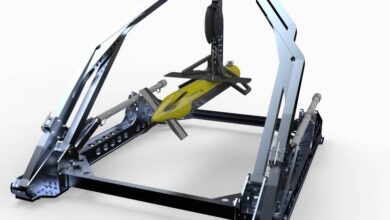UK Manufacturing Raise Robotics Uptake by Following Europe?

Automation Inspiration: Can UK Manufacturing Raise Robotics Uptake by Learning from Europe?
Despite punching well above our weight as a manufacturing powerhouse, the UK is in danger of slipping down the international rankings unless we increase our levels of automation. Now sitting at 25th in the global robotics league table1, we are the only G7 nation outside the top 20 and have been eclipsed by most of our European counterparts in terms of numbers of robots per 10,00 workers, including Italy, Belgium, Switzerland and the Czech Republic. Here, factory automation leader FANUC, which has subsidiaries across the world, examines the potential reasons behind the UK’s reluctance to automate – and asks what we can learn from our continental cousins…
An improving picture
The benefits to UK manufacturing of robotics and automation technology are greater than ever, helping us to meet net zero targets, boost productivity and underpin our key industries. And with an estimated 70,000 vacancies in manufacturing, robots are also alleviating the longstanding labour shortages which have only worsened since Brexit and COVID.
In regard to automation uptake, it is certainly an improving picture. Led by the automotive sector, UK robot installations were up by 3% in 2022, with operational stock growing by 7%. But at just 98 robots per 10,000 workers we are still well behind European leaders Germany (415).
UK: Focused on short-term ROI
Among the many potential explanations for this are a focus on short-term payback rather than longer-term total cost of ownership (TCO); a fear of change; outdated perceptions of engineering as a career; a lack of government incentives; our reliance on cheap manual labour; and no long-term national manufacturing strategy. While some of these are beginning to change – the government recently announced a £4.5bn package of support for British manufacturing, for example – should we also be looking to our European neighbours for some automation inspiration?
Germany: Prioritising precision and innovation
Dr Bob Struijk certainly thinks so. As the Vice President of FANUC Europe, Dr Struijk has overseen automation installations across numerous countries, and believes there are a variety of reasons why certain nations are further ahead of the UK on their automation journey.
“Germany is the clear European automation powerhouse and owes a large part of its success to a profound respect for engineering and manufacturing,” he explains. “The German model emphasises the meticulous craftsmanship of products, fostering a culture that places a premium on precision and innovation. Catapulted by the automotive industry, robotics and automation have been at the forefront of bringing Germany to its position today as a manufacturing leader.”
In addition, bridging the gap between industry and academia has helped to boost German innovation. “In Germany, collaborative efforts between industry and academia contribute to a continuous cycle of research, development and implementation, creating an ecosystem that thrives on technological advancement. The German apprenticeship system also provides a seamless flow of skilled labour into industry, at low cost. The UK can learn from this by cultivating a similar synergy between its educational institutions and industrial sector to breed a culture of continuous improvement.”
In this regard, FANUC UK is working hard to help develop a pipeline of manufacturing talent through a range of different initiatives. The company’s Training Academy at its Coventry HQ offers accredited courses that feed into educational programmes, giving students hands-on robotics experience; it recently held its first ever Work Experience Week, for young people aged 16-18; and the 2023 FANUC UK Open House played host to the finals of the WorldSkills UK Industrial Robotics competition.
However, for a nation built on SMEs, Dr Struijk is also clear that UK government support is critical to future success: “The penetration of robotics and automation in the UK is especially low among small and medium sized enterprises. Government tax breaks or accelerated depreciation of robots could certainly help to change this.”
Nordic nations: A supportive business environment
At sixth place in the global automation league table, Sweden boasts an impressive 343 robots for every 10,000 workers. Neighbours Denmark have 274, Finland has 168 and Norway has 103 – all sit higher than the UK.
“With their realistic approach towards return on investment (ROI), the Nordic countries have successfully integrated automation into their industries,” outlines Dr Struijk. “By focusing on the long-term benefits, these nations have cultivated a business environment that encourages companies to invest in automation technologies.”
By looking at TCO rather than just ROI – considering indirect cost savings such as reduced energy bills, less waste, higher productivity and increased production capacity – investing in automation could be a far more attractive proposition to UK manufacturers than it is today.
But again, the importance of government support cannot be overlooked, explains Dr Struijk:
“While the UK could draw inspiration from the Nordic model by fostering an environment where companies can confidently invest in automation, this must also be backed by supportive government policies and incentives,” he states. “In the Nordic countries, robust government initiatives have provided financial support and created favourable conditions for the adoption of automated solutions. For example, in the city of Odense, the government has stimulated the set-up of a ‘Robot Valley’ – a cluster of private companies, start-ups and academic institutions – that is helping to drive the Danish robotics market forward.”
Eastern Europe: Putting worker welfare first
Finally, Eastern European countries such as Slovakia, Hungary and the Czech Republic have embraced automation as a means of prioritising worker welfare.
“By automating dull, dirty and dangerous tasks, these nations have not only increased their manufacturing efficiency but have also enhanced the overall wellbeing of their workforce,” states Dr Struijk.
“They have benefitted from their close proximity to the German automotive market and used a combination of skilled labour and investment in robots to take a large share of the tier 1 market, as well as a host of greenfield investments by major European and Asian automakers. The UK could benefit by adopting a similar mindset; using automation to
alleviate workers from monotonous and hazardous tasks, thereby improving job satisfaction and increasing overall productivity.”
There is no doubt that manufacturing is already one of the UK’s greatest success stories. By investing in automation and robotics, UK manufacturers can help to futureproof their business and ensure we continue to compete on the international stage in the years to come.
Manufacturing & Engineering Magazine | The Home of Manufacturing Industry News



